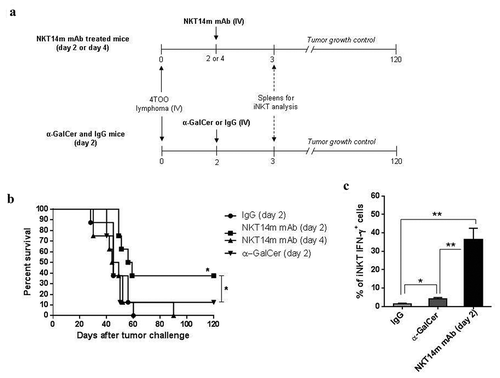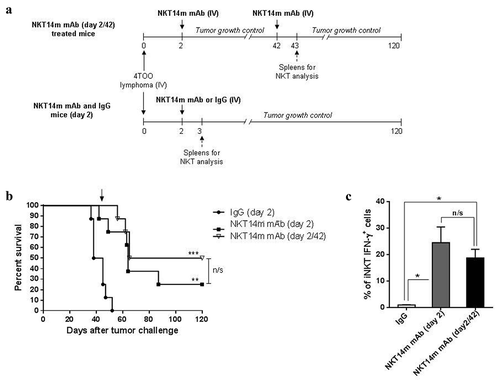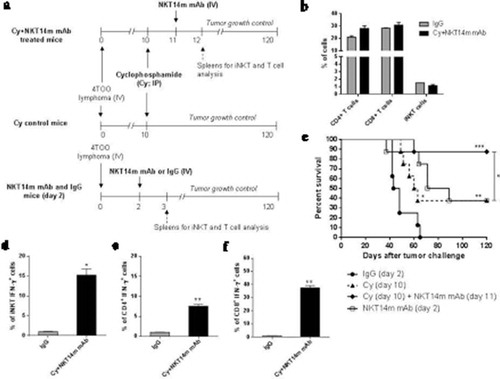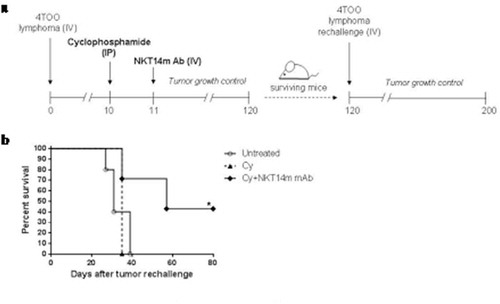Figures & data
Figure 1. The agonistic NKT14m mAb induces an effective in vivo antitumor response against B-cell lymphoma.
(a) Diagram of treatment schedule with NKT14m mAb and spleens harvest for iNKT-cell analysis. Balb/c mice (n = 8/group) were injected with 4 × 105 4TOO tumor cells (iv) on day 0 and were treated 2 or 4 days later with a single dose of NKT14m mAb (100μg/mice, iv) or IgG (100μg/mice, iv). A group of mice received α-GalCer (2μg/mice, iv) two days after tumor challenge. Mice were monitored daily for survival. Spleens of control and treated mice were harvested 3 days after tumor challenge (24h after each treatment) to detect IFN-γ producing iNKT cells. (b) Survival analysis of mice treated as described in (a). Data represents survival from one of three independent experiments. *p < 0.05. (c) Splenocytes (n = 4) were analyzed by flow cytometry for IFN-γ producing iNKT cells 24 hours (day 3) after NKT14m mAb and α-GalCer injection. Data are represented as mean ± SEM. **p < 0.01.

Figure 2. Retreatment with NKT14m mAb enhances the antitumor efficacy.
(a) Timeline of retreatment with NKT14m mAb and spleens harvest for iNKT-cell analysis. Balb/c mice (n = 8/group) were injected with 4 × 105 4TOO tumor cells (iv) and, 2 days later, treated with a single dose of NKT14m mAb (100μg/mice, iv) or control IgG (100μg/mice, iv). One group of treated mice was injected again with a single dose of NKT14m mAb (100μg/mice, iv) 42 days after tumor inoculation (NKT14m mAb day2/42). Mice were daily followed for survival. Spleens of control and treated mice were harvested 24 hours after each treatment (day 3 for NKT14m mAb and IgG groups, and day 43 for mice receiving antibody retreatment) for iNKT-cell analysis. (b) Survival analysis of mice treated as described in (a). Arrow indicates the day of retreatment. Data represents survival from one of three independent experiments. **p < 0.01; ***p < 0.001; n/s: no significance. (c) Splenocytes (n = 4) from mice treated with NKT14m or IgG at day 2, and mice that received a second dose of the antibody 42 days after tumor challenge, were analyzed by flow cytometry for IFN-γ producing iNKT cells, 24 hours after treatment in all cases (day 3 and day 43, respectively). Data are represented as mean ± SEM. *p < 0.05; n/s: no significance.

Figure 3. Treatment with cyclophosphamide following NKT14m mAb administration induces a potent antitumor response against B-cell lymphoma.
(a) Timeline of mice treatment with cyclophosphamide (Cy) and NKT14m mAb, and spleens harvest for iNKT and T-cell analysis. Balb/c mice (n = 8/group) were treated with Cy (70mg/kg; ip) 10 days after tumor challenge. One group of Cy treated mice received a single dose of NKT14m mAb (100μg/mice, iv) 24 hours after Cy injection (Cy+ NKT14m mAb). Another group of mice received a single dose of NKT14m mAb (100μg/mice, iv) 2 days after tumor challenge. Mice were monitored daily for survival. Spleens of control IgG and Cy+ NKT14m mAb groups were harvested 24 hours after each treatment (day 3 and day 12, respectively) for iNKT and T-cell analysis. (b) Percent of iNKT, CD4+ and CD8+ T cells were analyzed from spleens (n = 3) of mice treated with Cy+ NKT14m mAb and control IgG at day 12 after tumor challenge. n/s: no significance. (c) Survival analysis of treated mice as described in (a). Data represents survival from one of three independent experiments. *p < 0.05; **p < 0.01; ***p < 0.001. Splenocytes (n = 3) from Cy+ NKT14m treated mice were analyzed by flow cytometry for IFN-γ producing (d) iNKT, (e) CD4+ and (f) CD8+ T cells, 24 hours (day 12) after Cy+ NKT14m treatment. Data are represented as mean ± SEM. *p < 0.05; **p < 0.01.

Figure 4. Long-term immunity is induced by the combination of cyclophosphamide and NKT14m mAb.
(a) Mice immunized with Cy alone or Cy+ NKT14m treatment that survived the first 4TOO tumor injection (n = 3 and n = 7, respectively) were rechallenged with a second dose of tumor cells (4x105 cells/mouse, iv) at day 120. Mice were followed daily for survival. (b) Survival analysis of mice rechallenged with 4TOO tumor cells as described in (a). A group of untreated age-matched mice received an injection of 4 × 105 4TOO tumor cells as control. *p < 0.05.

